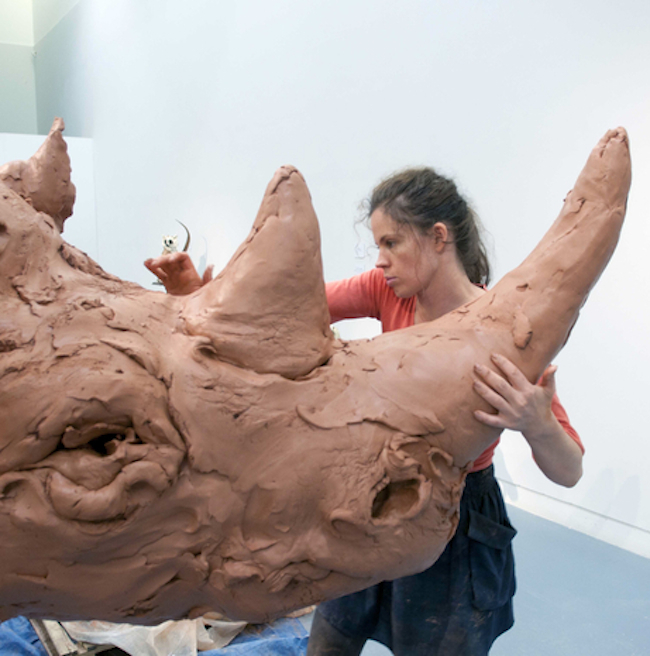LONDON — How much of life is sentient? Is awareness of self either on or off, or is it something with varying depths?
London-based artist Stephanie Quayle considers questions like those as she creates large-scale clay sculptures of animals. Cows, monkeys, rhinoceroses— all more or less retain their autonomy as different creatures, but there’s something human about them as well. Maybe it’s the way they stare the viewer directly in the eye. There are other hints, too. Subtle ones. Some of these sculptures, particularly the monkeys, are perched on everyday human objects such as shipping crates or stacks of books. They approach these objects with an ease that comes more from familiarity than ignorance.
Above image: Stephanie Quayle sculpting a rhinoceros at the International Ceramics Festival.
The most brazen crossover in her collection is Lion Man, a hybrid of a human form with a lion head. The figure evokes a hazy sense of recognition that suggests it was pulled from ancient mythology or deep within someone’s subconscious. How much of our experience is shared? Quayle can’t resolve that question but she gives us compelling food for thought. She describes her work as bringing together untamed, exotic, wild “otherness” of animals with domestic objects and the civilized spaces humans inhabit. This both highlights the tensions between ourselves and the animal world and, she states, “questions the boundaries of our inner animalness, drawing out an inner force intrinsic to our spirit.”
It shouldn’t surprise you that Quayle grew up on a farm. She was raised around domestic animals on the Isle of Man. She states of her work:
Living on a farm, immersed in the countryside environment and spending time in the wilderness of the Belize, Laos and Bangladesh are raw, vital experiences which informs and drives the work. Human souls are bound up in nature, so much of our selves resonates with animals, at our inner most essence we are animal, yet we no longer recognise our place in nature, we are displacing ourselves, the more separated we become, the unhappier we become.

Installation images of Stephanie Quayle, Two Cows, 2013, air-hardening clay with chicken wire and steel, 230 x 340 x 170 cm. Courtesy of the Saatchi Gallery. Click to see a larger image.
The Lion Man sculpture was made with air drying clay. Natasha Hoare, writing for the Saatchi Gallery, said that Quayle wants to work in the fastest, most direct way possible.
The process of sculpting each creature takes on a quasi-spiritual aspect in Quayle’s practice, resulting from a long process of sketching in front of her animal subject, and formed through layering up clay in a rapid process. “I want the fastest most direct, most subconscious way to work, vigorous and direct, the clay becomes inhabited. As old as mankind and coming directly from the ground, the clay seems to retain its primitive sense of earth, soil, mud and connection to the land.” Rendered at life scale, their presence in the gallery space is muscular and impressive, reanimating a sense of shared connection between living matter, an extra lingual sensation that has been lost in the progressive severing of the link between ourselves and nature rendered through technological process and the prevalence of the urban environment.
Stephanie Quayle was born in 1982 on the Isle of Man, according to her biography on the Cass Sculpture Foundation. She completed a BA (Hons) in Fine Art at London’s Slade School of Art in 2005 and an MA at the Royal College of Art in 2007. Quayle lives and works in the Isle of Man, UK.
Recent solo and group exhibitions include: Lion Man, TJ Boulting, London; Aberystwyth Arts Centre, Wales (2013); Collective Noun, Faggionato Fine Art, London (2011); Small Is Beautiful. Group show, Flowers East Gallery, London; A Curious Context , Canary Wharf Banf National Park, Canadian Ice Carving Competition; Zelli Porcelain show, London (2010); Bull in a China Shop, Trolley Gallery, London; Vixen. Cass Foundation, Goodwood Sculpture Park; Animal Farm , Mr Paisley’s Lashing, Homewood House (2009); Un-still Life Apartment Gallery, London; Tiger, Cass Foundation, Goodwood Sculpture Park; Fast and Furious, Dakha University, Bangladesh; Unnatural Habitats,Flowers East Gallery, Hoxton, London; The Clearing, Nettie Horn Gallery, London (2008); Little Brown job, 20 Hoxton Square, London; Bronze Age, Sculpture Prize Show, Limehouse, London; Muck ‘n’ Brass. Temporary Sculpture, Hyde Park (2007).
Do you love or loathe these works of contemporary ceramic art? Let us know in the comments.










Great work!
Love your sculptures Stephanie. I am writing a book on “Art and the Rhinoceros” and would like to use an image of your rhino in my book if that is okay with you.
Love these
Great Work!
Absolutely Love Stephanie’s sculptures – raw, vibrant, other worldly! More please!